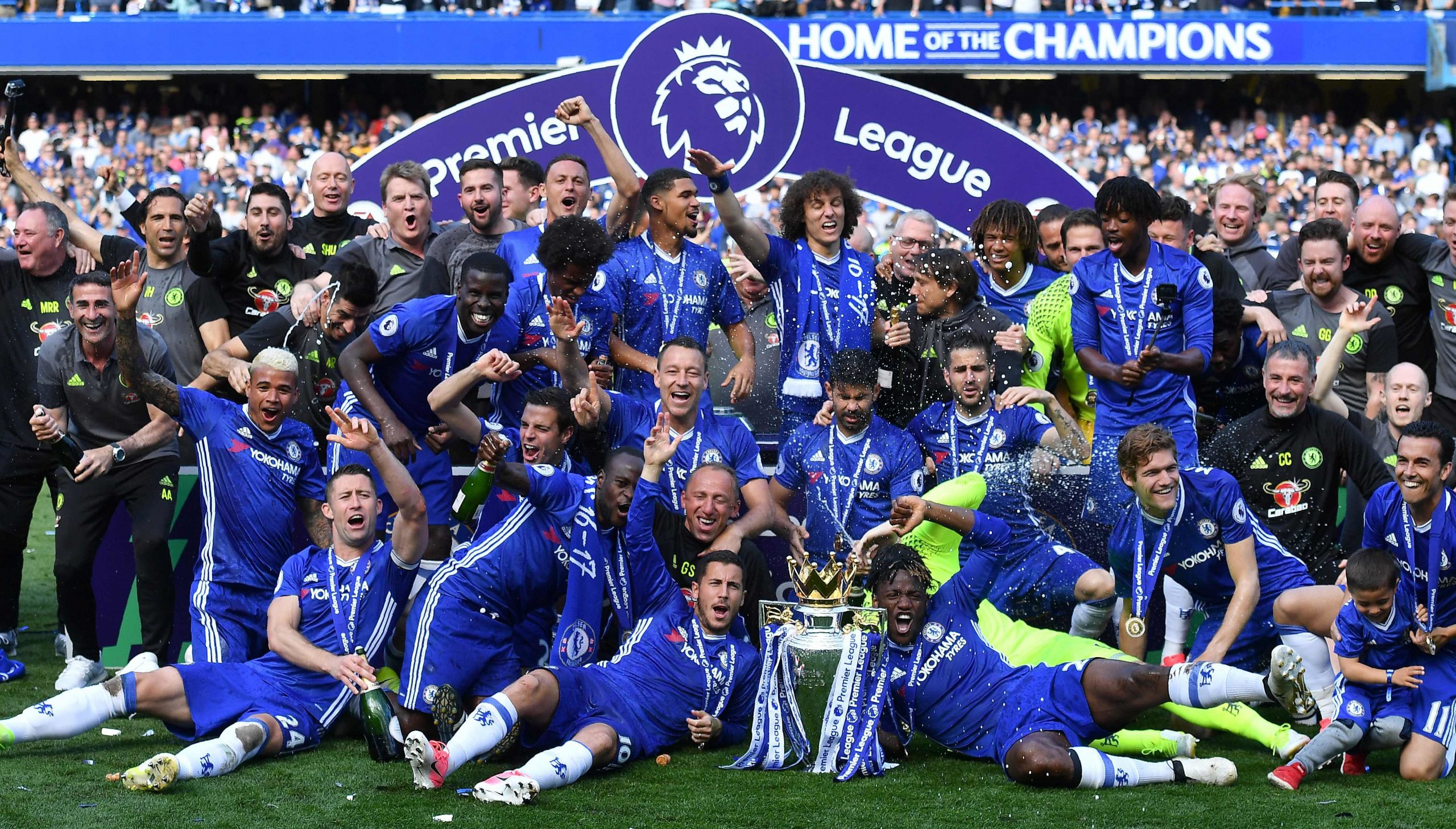After the madness of the 2015/16 Premier League season it appears normal service has been resumed. We head into 17/18 with Chelsea as defending champions once again, having strode to the title without really much fuss at all in the end.
Antonio Conte arrived, dug through the rubble left behind by his Portuguese predecessor, and restored the club to a spot at the top of English football. The squad Conte inherited was - despite its defective state - obviously fantastic. Nonetheless he should be applauded for reassembling them into a team with no real holes in their game. The move to a 3-4-3 was inspired and the speed with which the players adapted to it a testament to Conte's management. As was bringing Victor Moses out of the wilderness and somehow turning him into Cafu.
Any measure you want to look at, they ranked highly. The bedrock of their success being the killer combo of conceding a low amount of shots (8.5 per game, 3rd fewest in the league) + low quality of those shots. Between the 11th of December and the 25th of February they had a run where they conceded fewer than 10 shots in every match - 12 matches in total. They also made superb use of set pieces, scoring 22 goals from them, 9 goals more than any other top-6 team. Back to front they were just solid. Their defensive numbers might have been even better had they not spent the first few matches testing other formations.
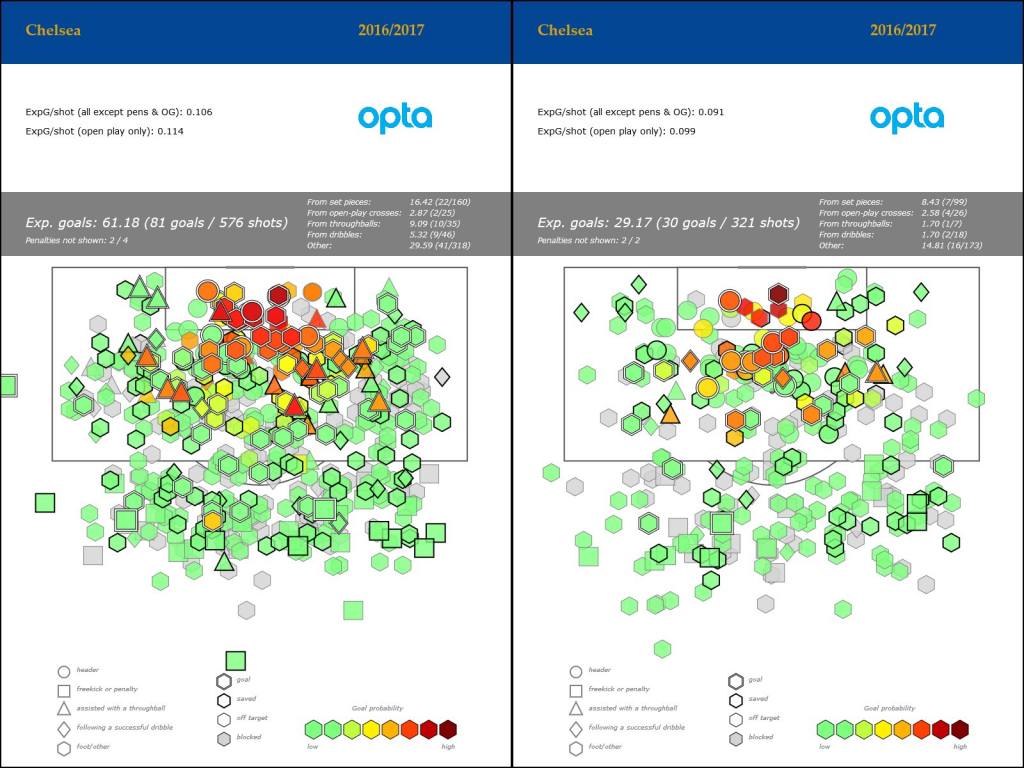
With that said, they were also fortunate in some aspects. They overshot their expected goals by a wide margin, racking up 81 non-penalty goals which was about 20 more than expected. Diego Costa was the main culprit in this, starting the season off with a ridiculously hot 14 goals in 19 matches. He cooled off, scoring just 6 goals in the final half of the season.
The rest of the team didn’t, including the highest conversion rate on shots from outside the box in the league (leading to 12 goals). As James Yorke has noted before this hot scoring was a part of them spending an unusually high amount of their game time in a winning position, never having to really chase a lead. This is also an ingredient that is common amongst title-winners of years gone by. With the margins at the very top of the league being so thin, these sorts of positive variance factors can help separate a team from the pack.
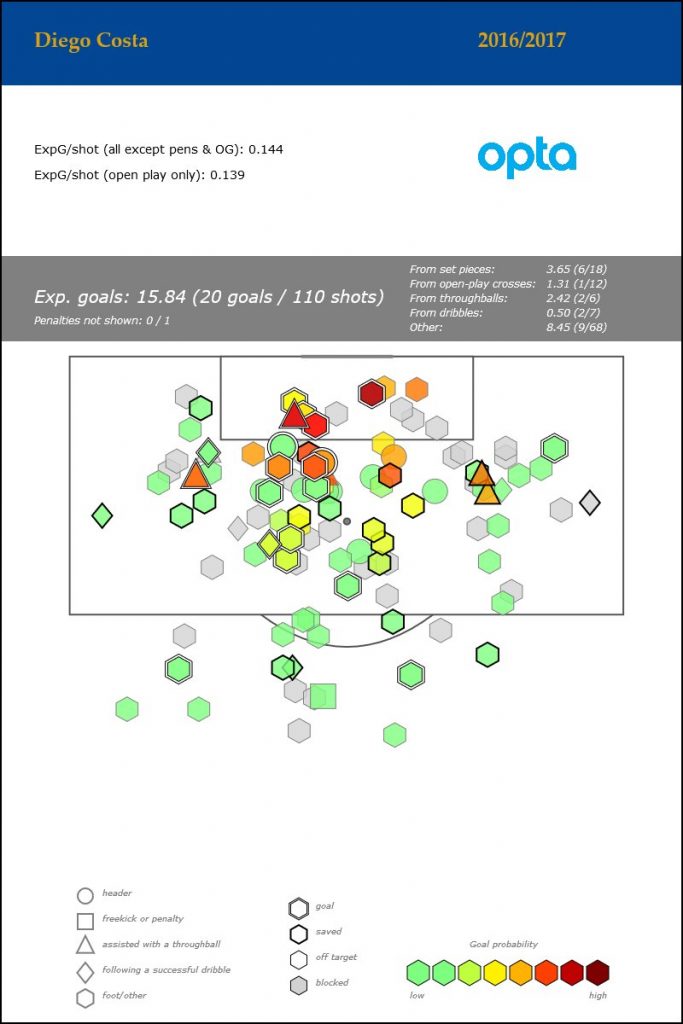
In reality though, all of this variance talk is a footnote. They were an excellent team with negligible flaws. As a result the objective for the upcoming seasons is clear: consolidate where they are and prepare for the added weight of the extra Champions League matches. They used the joint-2nd fewest players in the league last season and were mostly unfettered by injury. The squad needs fattening up.
Transfers
After three productive years Diego Costa is on the out and to replace him the club has brought in Real Madrid’s Álvaro Morata, for around £58m + vague add-ons. Morata’s production in previous seasons hints towards an impressive talent, yet it remains an opaque sample. At 24-years-old he’s never played over 1500 minutes in a league season and has never been the first choice striker on a team. 2016/17 La Liga was the first time in his career where his number of starts trumped his appearances off the bench, racking up a mind-boggling 15 goals and 4 assists in 1334 minutes.
Despite the small sample size his underlying numbers in that time are great and point to a fairly diverse range of skills. He attempted 21 headed shots (converting 6 of them), more than Costa has attempted in the last two seasons combined, and showed a penchant for creating decent shots off of dribbles, all with a skew towards the left side of the box - a preference that Costa shared. The overall shot selection is solid too with a very nice cluster (mostly headers) right in the middle of the box.
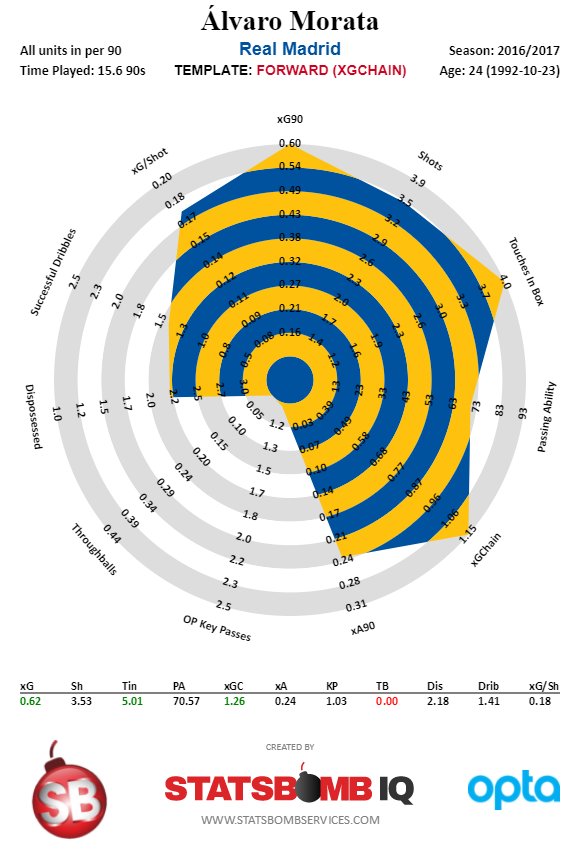
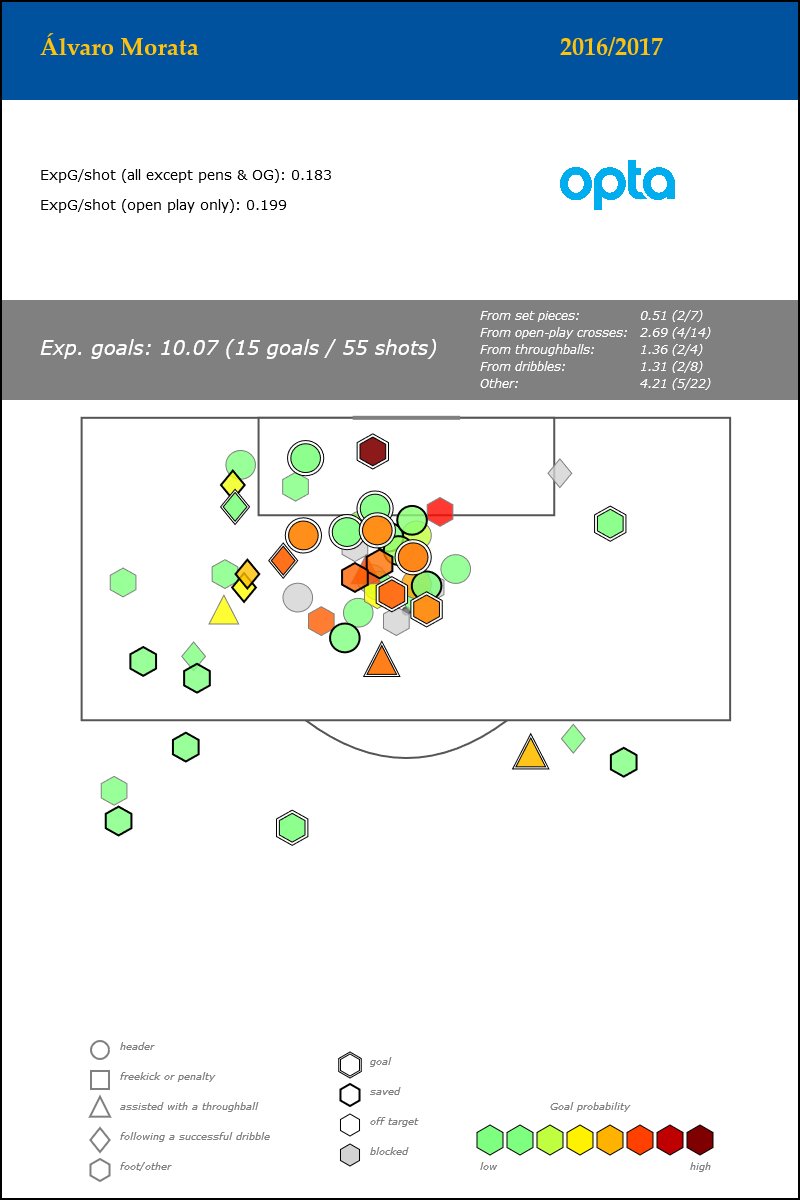
Looking back on his previous seasons, both in Madrid and in a similar role for Juventus, he’s never had a problem getting shots off. Not once has he dropped below 3 shots per90 in a league season, which includes as of late lopping off the long-rangers he once had a taste for. In fact, he’s never really had a problem with anything.
During limited minutes, season after season, he's repeatedly done everything that's been asked of him in terms of goalscoring and being a focal point at the top of European football. The question hanging over all of this though is how he’ll translate to a greater workload on a different team. Chelsea obviously have an elite set of talent but Real Madrid’s attacking firepower is as good as it gets and playing with them is likely to maximise a player's output. How much of his splendid 16-17 is down to situation? How much of it is small sample size theatre? Will Chelsea (having played the joint-third fewest crosses per game in the league last season) tailor their attack to his strengths, or will he fit into theirs?
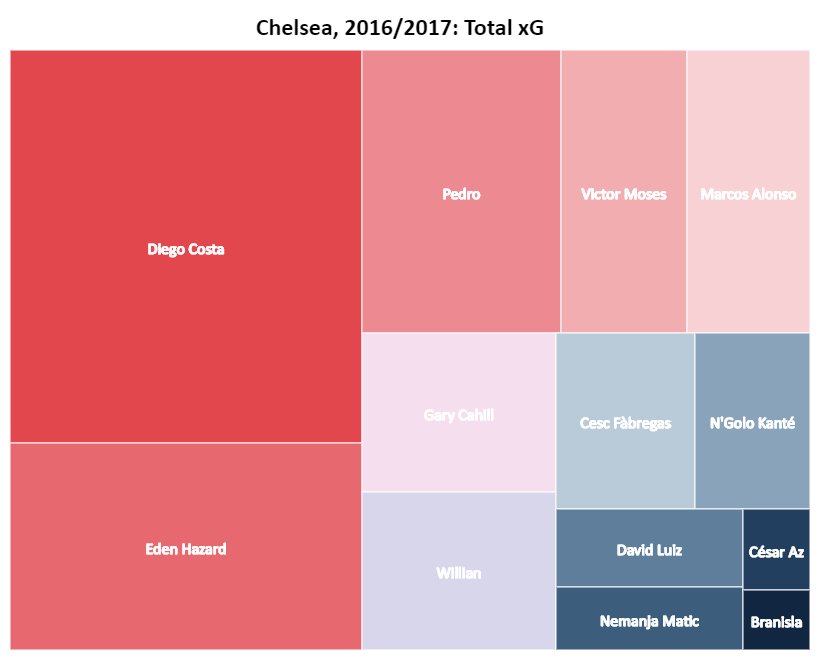
Morata is young, clearly very talented, carries no injury concerns and has a malleable enough skillset. It’s a smart gamble yet it remains a risk. One you might not expect a club in Chelsea's position to take. Brought in to bolster the midfield is 22-year-old Tiemoué Bakayoko, who spent last season at the heart of that Monaco side.
What immediately jumps out is his high number of dribbles, completing 2.16 out of a total 3.4 dribbles attempted per90 in Ligue 1 last season. That’s an unusually high number for a nominal defensive midfielder. More than both N'Golo Kanté and Nemanja Matić combined completed last season. It’s indicative of how furious an attack Monaco were that a DM was tearing through the middle of the pitch like a winger.
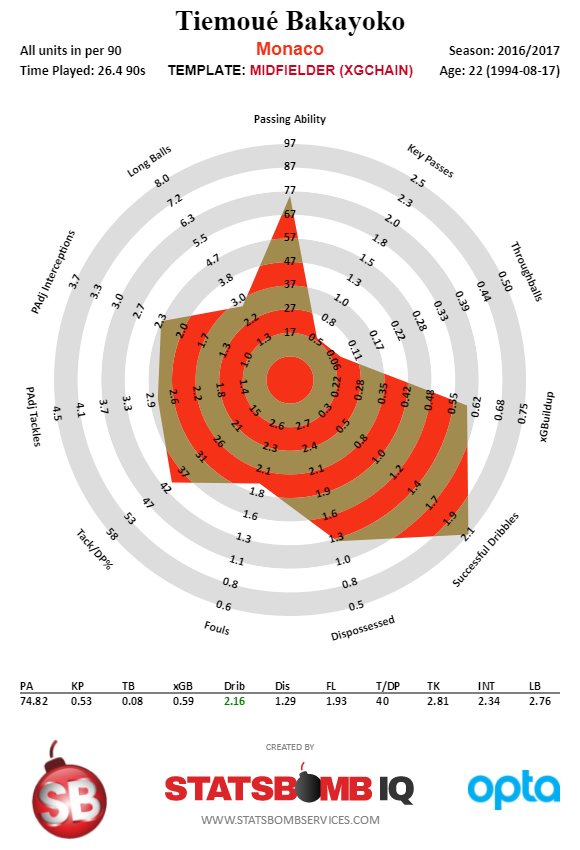
One suspects that the purpose of signing Bakayoko is twofold: to add a different option in terms of midfield ball progression and to lighten Kanté's load somewhat. While Matić’s creative contribution has stayed the same with time, his defensive activity has lowered. In the 14/15 title-winning season the Serb's defensive numbers were actually pretty Kanté-esque: a split of 2.35 Padj interceptions per90, 4.07 Padj Tackles per90 and a 43% Tackle/Dribbled past %. In 16/17 this changed to 1.70/1.89/40%. Is this age or is it the effect of playing next to Kanté? Or both?
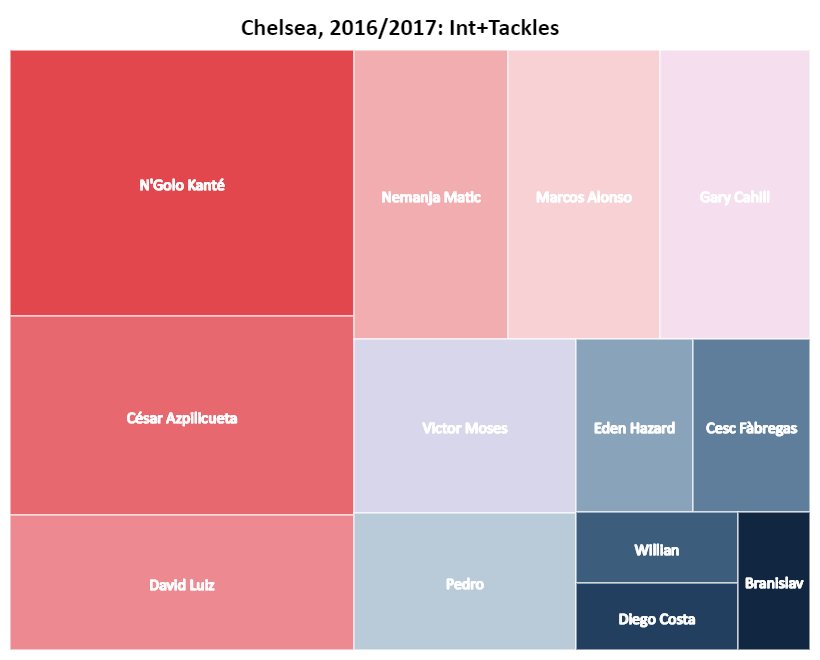
Regardless of the answer the end result is that Kanté ends up doing a lot of work. He’s sustained his energy for two full seasons now but with the addition of a Champions League campaign the workload will be greater than he's ever dealt with before. Bakayako is not the same type of defensive wizard as his compatriot, nor is he as exceptional in any one facet of the game, making the £40m fee seem a tad high. Nevertheless he's a well-rounded midfielder with time to improve who can both compliment Kanté and fill in for him against certain teams.
Having him in the fold helps ease the weight on Kanté's shoulders. However that easing is reduced now that Matić has left Chelsea to re-join José Mourinho at Manchester United, leaving the depth situation somewhat back at square one. Moving forward having a a young Bakayoko is better than having a 29-year-old Matić but it's all a bit moot if your two main midfielders are exhausted and one injury away from panic stations. Bakayoko's value as a different form of creator (a dribbler with good but not great passing ability) is also lessened when rather than an alternative he becomes the main option.
Chelsea may have to use Cesc more often or switch up the formation if they want meaningful passing in midfield, a route which of course brings its own headaches. We'll have to see what the rest of the transfer window brings on this one. Finally, slotting in at centre back, is Antonio Rüdiger. This is a quietly intriguing purchase as the German has a few quirks.
Despite being a CB he has moonlighted as a fullback on numerous occasions during his time at Roma (mainly on the right) meaning his game is a mishmash of skills. He completed 0.7 dribbles per90 for last season which, like Bakayoko, is on the high side for his position, even when you factor in the odd game at FB.
His passing numbers also are closer to David Luiz in terms of adventurousness (many an attempted long ball) than they are Gary Cahill. At 24-years-old it’s likely that his role will start out small, growing in the future as Luiz and Cahill - both in their 30s - age out of contention. Roma used him in a three-at-the-back, something Conte no doubt took note of, and his positional flexibility means he could fill in for Victor Moses too should the situation demand it. Perhaps Kurt Zouma (who has just been loaned to Stoke) could have filled that role but for now it appears Conte doesn’t consider him ready. Andreas Christensen - who impressed on loan at Borussia Mönchengladbach - has been preferred instead.
Michy
The case of Michy Batshuayi is an odd one.
Chelsea bought him last summer for around £33m off the back of a 15 open play goals(+2 pens)/9 assists season at Marseille, with some great expected goals numbers to boot. At Chelsea he has played a total of 239 league minutes, almost all of them in short cameos off the bench, with one token start in the dying embers of the season. It makes sense that he didn’t play much in the first half of the season given that Diego Costa was on a ridiculously hot run of goalscoring. Yet in the second half, when Costa regressed, he didn’t get a look in.
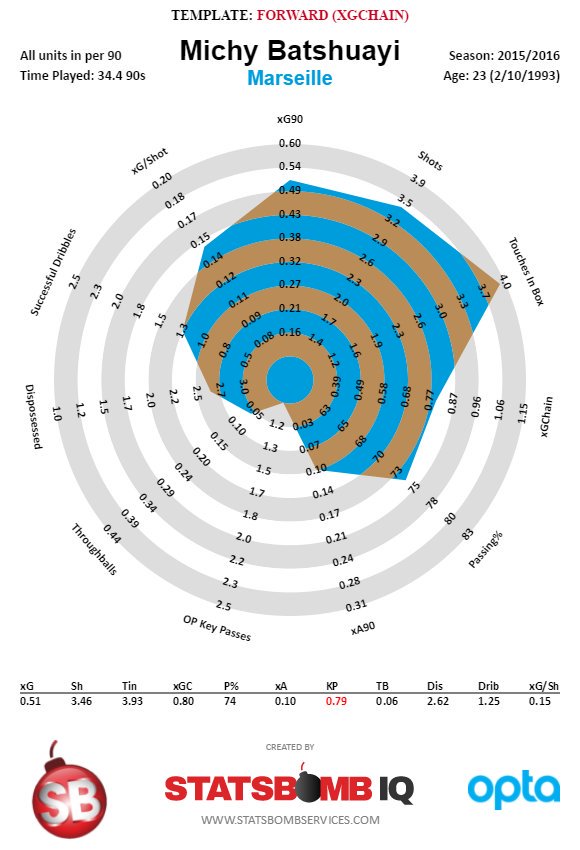
Michy for his part was also red hot in those minuscule minutes, scoring 5 goals (including the one that clinched the title) with xG output to match but it isn't clear how real that production is. At 23-years-old the club needs a bigger sample size so they can figure out what they actually have with him. If he had played more time and continued to produce then maybe the club doesn’t have to buy Morata this summer.
Instead of gambling on the young striker from elsewhere they can gamble on the young striker already on their books. Now there’s talk that he won't even be Morata’s backup, that the club is looking for an extra striker and Michy will be loaned elsewhere. We lack the context of what goes on in training and behind closed doors. Context that might illuminate why he has been handled this way. From an outsider’s perspective though, it’s confusing. Going into 2017/18 there are a few nagging concerns if you’re a Chelsea supporter.
The midfield situation will likely be solved in some fashion before the transfer window ends but others - wingback and attacking midfield particularly - are less certain. The dual broad objectives of replacing Diego Costa and filling out the squad have only been half accomplished at this point. There are slight opportunities for regression and an apprehension about how good Morata will be but these aren’t apocalyptic concerns. As things stand though, there's still a few holes to fill.
